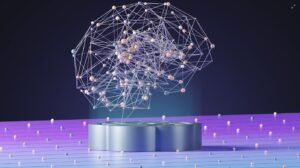Difference Between AI vs Machine Learning
Artificial Intelligence (AI) and Machine Learning (ML) are two terms that are often used interchangeably, but they are not the same thing. While both concepts deal with the field of computer science and have some overlapping characteristics, they have distinct differences.
Key Takeaways:
- AI is a broad field of computer science that focuses on creating machines that can simulate human intelligence, while ML is a subfield of AI that allows machines to learn from data without being explicitly programmed.
- AI aims to create intelligent machines that can perform tasks that typically require human intelligence, while ML focuses on the development of algorithms that enable machines to learn and make predictions or decisions based on data.
- AI can be broadly categorized into two types: narrow AI (focused on specific tasks) and general AI (possessing human-level intelligence), whereas ML is mainly concerned with developing algorithms for pattern recognition and predictive analytics.
- Both AI and ML have numerous real-world applications across various industries, including healthcare, finance, transportation, and more.
Understanding AI and Machine Learning
**Artificial Intelligence (AI)** is a field of computer science that focuses on creating machines capable of simulating human intelligence. It encompasses a broad range of techniques, including natural language processing, problem-solving, perception, and machine vision. AI can be classified into two categories: narrow AI and general AI. Narrow AI refers to systems designed to perform specific tasks, such as recognizing images or playing chess, while general AI aims to develop machines that possess human-like intelligence across a wide range of tasks.
*AI has been powering innovations and advancements in various industries such as autonomous vehicles, personalized healthcare, and virtual assistants, with the potential to revolutionize the way we live and work.*
**Machine Learning (ML)**, on the other hand, is a subfield of AI that focuses on the development of algorithms and statistical models that enable machines to learn from data without being explicitly programmed. The primary goal of ML is to allow computers to learn and make predictions or decisions based on patterns and data. ML algorithms are designed to automatically improve their performance over time as they are exposed to more data.
*Machine learning algorithms have been at the core of many disruptive technologies we use today, such as recommendation systems (e.g., Netflix), spam filters, fraud detection, and voice recognition systems.*
Differences Between AI and Machine Learning
While AI and ML are often used together, it’s important to understand their differences:
1. Approach
AI focuses on developing systems that can mimic human intelligence, whereas ML focuses on developing algorithms that allow machines to learn and improve from data.
2. Programming
AI systems are explicitly programmed to perform specific tasks, while ML algorithms learn from data without being explicitly programmed.
3. Flexibility
AI systems are typically less flexible as they are designed for specific tasks, while ML algorithms can adapt and learn from new data to improve their performance over time.
Applications of AI and Machine Learning
AI and ML have revolutionized various industries, enabling advancements and innovation in many sectors. Here are some notable applications:
| Industry | Application |
|---|---|
| Healthcare | Medical diagnosis, drug development, personalized treatment plans |
| Finance | Fraud detection, algorithmic trading, customer service bots |
| Transportation | Autonomous vehicles, route optimization, traffic prediction |
*The potential of AI and ML in transforming healthcare, finance, transportation, and other industries is immense, allowing for more accurate diagnoses, better customer experiences, and increased efficiency.*
Conclusion
AI and ML are closely related concepts, but they have distinct differences. AI focuses on creating machines that simulate human intelligence, while ML enables machines to learn and make predictions based on data. Both AI and ML have a wide range of applications, driving innovation in various industries and shaping the future of technology.

Common Misconceptions
Misconception 1: AI and Machine Learning are the same
One common misconception is that AI and Machine Learning are interchangeable terms, but in reality, they are different concepts. AI is a broader field that encompasses a range of technologies and techniques used to simulate human intelligence in machines. On the other hand, Machine Learning is a subset of AI that focuses on enabling machines to learn from data and improve their performance without explicit programming.
- AI includes robotics and natural language processing, which are not part of Machine Learning.
- Machine Learning relies on algorithms and statistical models to learn from data.
- AI has been used in various industries, including healthcare and finance, while Machine Learning is commonly used in data analysis and prediction tasks.
Misconception 2: AI will replace human jobs
Another misconception surrounding AI is that it will inevitably lead to widespread unemployment as machines and robots take over human jobs. While AI certainly has the potential to automate certain tasks and roles, it is unlikely to replace human workers entirely. Instead, AI is more likely to augment human capabilities, allowing workers to focus on more complex and creative tasks that require human judgment.
- AI often complements human skills by automating repetitive and mundane tasks.
- New job opportunities can arise as AI advances, creating roles that work alongside AI technologies.
- Human empathy, critical thinking, and emotional intelligence are difficult for AI to replicate, making certain roles still crucial for humans.
Misconception 3: AI and Machine Learning always work perfectly
Many people believe that AI and Machine Learning algorithms are infallible and always produce accurate and flawless results. In reality, these technologies are not perfect and can encounter various challenges and limitations. Machine Learning models rely heavily on the quality and quantity of data used for training, and if the data is biased or insufficient, the model’s predictions may be skewed. Additionally, AI systems can struggle when dealing with new and unfamiliar situations that were not part of their training data.
- Machine Learning models can be biased if the training data contains biased or unrepresentative samples.
- Data quality is crucial for accurate predictions, and incomplete or noisy data can lead to poor results.
- AI systems require continuous monitoring and updates to adapt to changing circumstances and new scenarios.
Misconception 4: AI is only useful for big companies
There is a common perception that AI and Machine Learning are technologies reserved only for large corporations with significant resources. However, AI is increasingly becoming accessible to businesses of all sizes. Many cloud-based AI services, such as natural language processing and computer vision APIs, are affordable and easy to integrate into applications and platforms. Additionally, open-source Machine Learning libraries and frameworks enable businesses to develop their AI solutions without breaking the bank.
- Small businesses can benefit from AI-powered chatbots for customer support and personalized recommendations.
- Cloud-based AI services eliminate the need for extensive infrastructure and upfront investments.
- Open-source Machine Learning frameworks like TensorFlow and scikit-learn allow businesses to develop AI applications at a low cost.
Misconception 5: AI is only science fiction
Some people still perceive AI as a futuristic concept depicted in science fiction movies, far from reality. However, the reality is that AI and Machine Learning are already heavily integrated into our daily lives and various industries. From voice assistants like Siri and Alexa to recommendation systems on shopping websites, AI technologies are present and actively improving our user experiences. AI is not just a vision of a distant future; it is a tangible and rapidly advancing field.
- Voice recognition technology and virtual assistants have become common in smartphones and smart speakers.
- AI-based recommendation systems are used by e-commerce platforms to suggest personalized products.
- Applications of AI in healthcare, finance, and transportation are already making significant impacts.

The Rise of Artificial Intelligence (AI)
In recent years, artificial intelligence (AI) has emerged as a groundbreaking technology with the ability to improve various aspects of our lives. AI refers to the simulation of human intelligence in machines that are programmed to think and learn like humans. It encompasses a wide range of technologies, including machine learning, which is a subset of AI. Below, we explore the differences between AI and machine learning through informative tables:
Table: Key Differences between AI and Machine Learning
The following table highlights the fundamental distinctions between AI and machine learning:
| Factor | Artificial Intelligence (AI) | Machine Learning |
|---|---|---|
| Definition | A technology that enables machines to perform tasks requiring human intelligence. | A subset of AI that enables machines to learn from data and improve their performance without explicit programming. |
| Application | Widely used in various industries, including healthcare, finance, and transportation, for enhanced decision-making, automation, and problem-solving. | Applied in predictive analytics, pattern recognition, and data mining to make accurate predictions or take actions based on existing data. |
| Capability | Includes reasoning, problem-solving, understanding natural language, and general intelligence. | Focuses on learning from data, identifying patterns, and making data-driven predictions or decisions. |
| Data Dependency | More reliant on structured and unstructured data, as well as algorithms, to produce intelligent outputs. | Relies heavily on data, algorithms, and statistical techniques to build models and make accurate predictions. |
| Autonomy | Can operate with minimal human intervention and perform complex tasks requiring human intelligence. | Can autonomously analyze large datasets, derive insights, and make accurate predictions, but limited to specific tasks. |
Machine Learning Algorithms vs Artificial Intelligence
Understanding the various machine learning algorithms and how they differ from AI is essential. The table below outlines some popular machine learning algorithms and their applications:
| Algorithm | Application |
|---|---|
| Linear Regression | Predicting stock prices or house prices based on historical data. |
| Decision Trees | Classification problems like predicting customer churn or spam detection. |
| Support Vector Machines (SVM) | Image recognition, text classification, and hand-written character recognition. |
| Neural Networks | Speech recognition, object detection, and natural language processing. |
| K-means Clustering | Segmenting customer groups, image compression, and anomaly detection. |
The Impact of AI and Machine Learning in Society
The integration of AI and machine learning has significantly impacted society. Here are three key areas where their influence has been profound:
| Aspect | Impact |
|---|---|
| Finance | Increased efficiency in fraud detection, algorithmic trading, and personalized financial advice. |
| Healthcare | Enhanced diagnostics, precision medicine, and predictive analytics for early disease detection. |
| Transportation | Improved autonomous vehicles, traffic management, and predictive maintenance for efficient operations. |
Limitations of AI and Machine Learning
Despite their immense potential, AI and machine learning possess certain limitations that must be considered. The table below highlights a few key limitations:
| Limitation | Explanation |
|---|---|
| Data Dependency | Insufficient or biased data can lead to inaccurate predictions or reinforce existing biases. |
| Interpretability | Models like deep neural networks can be hard to interpret, making it challenging to understand their decision-making process. |
| Privacy and Security | Handling sensitive data raises concerns regarding security breaches and unauthorized access. |
AI vs Machine Learning: Which One to Choose?
Choosing between AI and machine learning depends on the desired outcome and specific requirements. The table below provides insights to help determine the appropriate technology:
| Factor | AI | Machine Learning |
|---|---|---|
| Complexity | Ideal for projects requiring advanced reasoning and decision-making capabilities. | Well-suited for tasks where pattern recognition and prediction are the primary objectives. |
| Time and Resources | Generally more time-consuming and resource-intensive due to complex implementation and extensive training. | Relatively faster to implement, particularly for well-defined tasks, and requires less training. |
| Scalability | Can handle complex and evolving tasks, making it suitable for scalable solutions. | Can scale to handle large datasets and improved predictions but may struggle with highly dynamic tasks. |
The Future of AI and Machine Learning
In summary, the future looks promising for AI and machine learning. These technologies have already made groundbreaking advancements and will continue to transform various industries. It is crucial to understand their differences, limitations, and applications to leverage their potential while addressing any ethical concerns that may arise along the way.
Frequently Asked Questions
What is the difference between Artificial Intelligence (AI) and Machine Learning (ML)?
Artificial Intelligence (AI) is a broad field that focuses on creating machines or systems that can perform tasks requiring human-like intelligence. Machine Learning (ML) is a specific subfield of AI that focuses on the development of algorithms and statistical models that enable machines to learn from data and improve their performance over time.
How does AI differ from traditional programming?
Traditional programming involves explicitly instructing a computer on how to perform a specific task, whereas AI involves enabling machines to learn from data and make decisions on their own without explicit programming.
Can you give an example to differentiate AI and ML?
Imagine an AI-powered chatbot that can hold conversations with users. The AI component enables the chatbot to interpret the user’s input, understand the context, and generate meaningful responses. Machine Learning comes into play when the chatbot learns from its interactions with users and improves its responses over time based on the patterns it discovers in the data.
What are the main techniques used in AI and ML?
The main techniques used in AI and ML include neural networks, deep learning, reinforcement learning, natural language processing, computer vision, and evolutionary algorithms.
How are AI and ML applied in real-world scenarios?
AI and ML have diverse applications in various industries. They can be used for image and speech recognition, fraud detection, autonomous vehicles, virtual assistants, personalized recommendation systems, medical diagnoses, and many more.
Are AI and ML inseparable?
While AI and ML have a strong connection, they are not inseparable. AI refers to the broader field encompassing various approaches, including ML but also other techniques such as rule-based systems and expert systems. ML, on the other hand, is a specific subset of AI that focuses on statistical learning.
Do all AI systems use ML algorithms?
No, not all AI systems rely on ML algorithms. AI encompasses a wide range of techniques and approaches. ML is just one of them, and AI systems can leverage other methods such as knowledge-based systems, rule-based systems, or expert systems.
Can ML algorithms function without AI?
Machine Learning algorithms can function independently of AI systems. ML algorithms can be used in various applications, even without having an integrated AI component. However, the use of ML algorithms within an AI system can enhance its capabilities and improve its decision-making abilities.
Is deep learning a type of AI or ML?
Deep Learning is a subset of Machine Learning, which itself is a subset of Artificial Intelligence. Deep Learning involves training artificial neural networks with multiple hidden layers to recognize patterns and make predictions or classifications.
Are there any limitations or challenges in AI and ML?
Yes, there are several challenges and limitations in AI and ML. Some of the main challenges include the lack of interpretability and transparency in certain AI models, the potential for biased decision-making, the need for vast amounts of high-quality training data, the complexity of model selection and optimization, and ethical concerns surrounding the deployment of AI systems.




